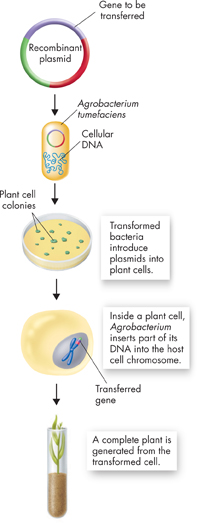Transgenic Organisms
 How can genes from one organism be inserted into another organism?
How can genes from one organism be inserted into another organism?
The universal nature of the genetic code makes it possible to construct organisms that are transgenic, containing genes from other species.  Transgenic organisms can be produced by the insertion of recombinant DNA into the genome of a host organism. Like bacterial plasmids, the DNA molecules used for transformation of plant and animal cells contain genetic markers that help scientists identify which cells have been transformed.
Transgenic organisms can be produced by the insertion of recombinant DNA into the genome of a host organism. Like bacterial plasmids, the DNA molecules used for transformation of plant and animal cells contain genetic markers that help scientists identify which cells have been transformed.
Transgenic technology was perfected using mice in the 1980s. Genetic engineers can now produce transgenic plants, animals, and microorganisms. By examining the traits of a genetically modified organism, it is possible to learn about the function of the transferred gene. This ability has contributed greatly to our understanding of gene regulation and expression.

FIGURE 15–11 Transforming a Plant Cell Agrobacterium can be used to introduce bacterial DNA into a plant cell. The transformed cells can be cultured to produce adult plants.
ddTransgenic Plants Many plant cells can be transformed using Agrobacterium. In nature this bacterium inserts a small DNA plasmid that produces tumors in a plant's cells. Scientists can deactivate the plasmid's tumor-producing gene and replace it with a piece of recombinant DNA. The recombinant plasmid can then be used to infect and transform plant cells, as shown in Figure 15–11.
There are other ways to produce transgenic plants as well. When their cell walls are removed, plant cells in culture will sometimes take up DNA on their own. DNA can also be injected directly into some cells. If transformation is successful, the recombinant DNA is integrated into one of the plant cell's chromosomes.
Transgenic Animals Scientists can transform animal cells using some of the same techniques used for plant cells. The egg cells of many animals are large enough that DNA can be injected directly into the nucleus. Once the DNA is in the nucleus, enzymes that are normally responsible for DNA repair and recombination may help insert the foreign DNA into the chromosomes of the injected cell.
Recently it has become possible to eliminate particular genes by carefully engineering the DNA molecules that are used for transformation. The DNA molecules can be constructed with two ends that will sometimes recombine with specific sequences in the host chromosome. Once they do, the host gene normally found between those two sequences may be lost or specifically replaced with a new gene. This kind of gene replacement has made it possible to pinpoint the specific functions of genes in many organisms, including mice.
Table of Contents
- Formulas and Equations
- Applying Formulas and Equations
- Mean, Median, and Mode
- Estimation
- Using Measurements in Calculations
- Effects of Measurement Errors
- Accuracy
- Precision
- Comparing Accuracy and Precision
- Significant Figures
- Calculating With Significant Figures
- Scientific Notation
- Calculating With Scientific Notation
- Dimensional Analysis
- Applying Dimensional Analysis




